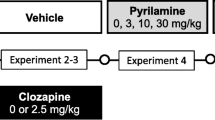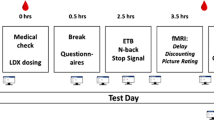Abstract
Fluoxetine is a specific and long-lasting inhibitor of serotonin reuptake. In free-feeding rats a dose of 10 mg/kg reduced meal size but had no significant effect on meal frequency. Feeding rate during meals was also reduced. Direct observation of behaviour associated with eating suggested that fluoxetine did not act by enhancing sleep or other behaviour patterns that interfere with eating, although the transition from feeding to sleep occured more rapidly after drug treatment. Enhancement of satiety or interference with the sustaining of meals by fluoxetine would be consistent with these data. Rebound feeding after anorexia was not observed in either the meal pattern study or in a separate experiment using schedule fed animals. There was also no clear development of tolerance to the anorectic effect of fluoxetine, and we discuss possible reasons for an association of these two properties.
Similar content being viewed by others
References
Altmann J (1974) Observational study of behaviour: sampling methods. Behaviour 49:227–267
Antin J, Gibbs J, Holt J, Young, RC, Smith GP (1975) Choleocystokinin elicits the complete behavioural sequence of satiety in rats. J Comp Physiol Psychol 89:784–790
Baker TB, Tiffany ST (1985) Morphine tolerance as habituation. Psychol Rev 92:70–108
Blundell JE (1986) Serotonin manipulations and the structure of feeding behaviour. Appetite 7:39–56
Blundell JE, Latham CJ (1978) Pharmacological manipulation of feeding behaviour: possible influences of serotonin and dopamine on food intake. In: Garattini S, Saminin R (eds) Central mechanisms of anorectic drugs. Raven Press, New York, pp 83–109
Burton MJ, Cooper SJ, Popplewell DA (1981) The effect of fenfluramine on the microstructure of feeding and drinking in the rat. Br J Pharmacol 72:621–633
Clifton PG (1987) Analysis of feeding and drinking patterns. In: Rowland N, Toates F (eds) Methods and techniques to study feeding and drinking behaviour. Elsevier Press, Amsterdam, pp 19–35
Clifton PG, Popplewell DA, Burton MJ (1984) Feeding rate and meal patterns in the laboratory rat. Physiol Behav32:369–374
Davies RF, Rossi J, Panksepp J, Bean NJ, Zolovick AJ (1983) Fenfluramine anorexia: a peripheral locus of action. Physiol Behav 30:723–730
Dumont C, Laurent J, Grandadam A, Boissier JR (1981) Anorectic properties of a new long acting serotonin uptake inhibitor. Life Sci 28:1939–1945
Garattini S, Mennini T, Beuclotti C, Invernizzi R, Samanin R (1986) Neurochemical mechanism of action of drugs which modify feeding via the serotonergic system. Appetite 7:15–38
Grinker JA, Drewnowski A, Enns M, Kissileff H (1980) Effects of d-amphetamine and fenfluramine on feeding problems and activity of obese and lean Zucker rats. Pharmacol Biochem Behav 12:265–275
Kim S-H, Wurtman RJ (1988) Selective effects of CGS 10686B, dl-fenfluramine or fluoxetine on nutrient selection. Physiol Behav 42:319–322
Kirkham TC, Blundell JE (1987) Effects of naloxone and naltrexone on meal patterns of freely-feeding rats. Pharmacol Biochem Behav 26:515–520
Kushner LR, Mook DG (1984) Behavioral correlates of oral and postingestive satiety in the rat. Physiol Behav 33:713–718
Liebowitz SF, Shor-Posner G, Maclow C, Grinker JA (1986) Amphetamine: effects on meal patterns and macronutrient selection. Br Res Bull 17:681–689
Popplewell DA (1981) Microstructural analysis of rat feeding: Applications to neurochemical theories of intake control. D Phil Thesis, University of Sussex
Rowland NE, Carlton J (1983) Different behavioral mechanisms underlie tolerance to the anorectic effects of fenfluramine and quipazine. Psychopharmacology 81:155–157
Rowland NE, Carlton J (1986) Neurobiology of an anorectic drug: Fenfluramine. Prog Neurobiol 27:13–62
Rowland NE, Bartness T, Carlton J, Antelman S, Kocan D (1981) Tolerance and sensitisation of the effects of various anorectics. In: Hoebel BG, Novin D (eds) The neural basis of feeding and reward. Proceedings of “The neural basis of feeding and reward”, Satellite symposium of Society for Neuroscience Annual Meeting, Los Angeles, California
Rowland NE, Antelman SM, Kocan D (1982) Differences among “serotonergic” anorectics in a cross-tolerance study: to they all act on serotonin systems? Eur J Pharmacol 81:57–66
Siegel S (1975) Evidence from rats that morphine tolerance is a learned process. J Comp Physiol Psychol 89:498–506
Siegel S (1977) Morphine tolerance acquisition as an associative process. J Exp Psychol: Anim Behav Proc 3:1–13
Solomon RL, Corbit JD (1974) An opponent-process theory of motivation: I Temporal dynamics of affect. Psychol Rev 81:119–145
Wong DT, Bymaster FP, Horng JS, Molloy BB (1975) A new selective inhibitor of uptake of serotonin into synaptosomes of rat brain: 3-(p-trifluoromethylphenoxy)-N-methyl-3-phenyl-propylamine. J Pharmacol Exp Ther 193:804–811
Author information
Authors and Affiliations
Rights and permissions
About this article
Cite this article
Clifton, P.G., Barnfield, A.M.C. & Philcox, L. A behavioural profile of fluoxetine-induced anorexia. Psychopharmacology 97, 89–95 (1989). https://doi.org/10.1007/BF00443419
Received:
Accepted:
Issue Date:
DOI: https://doi.org/10.1007/BF00443419




